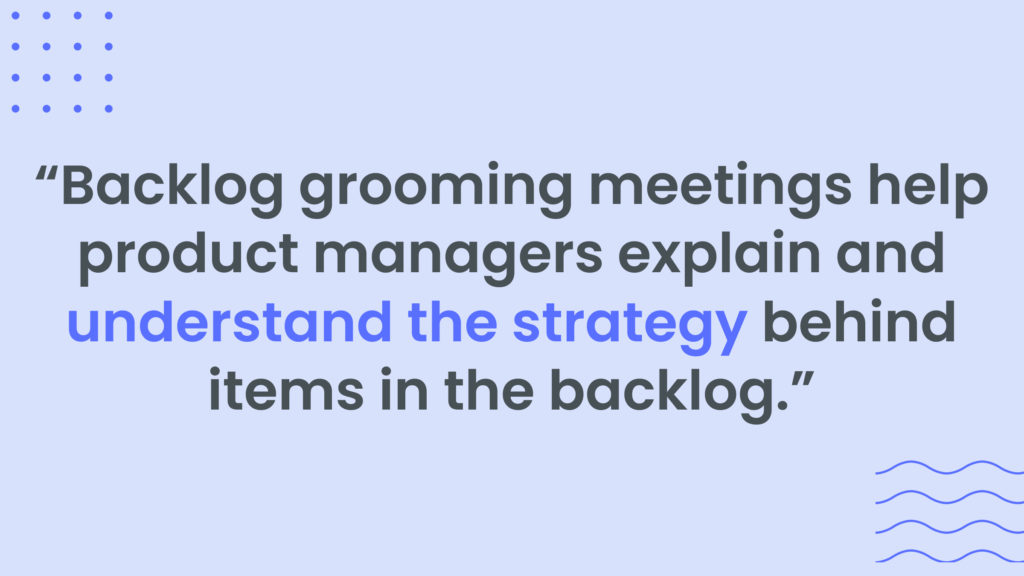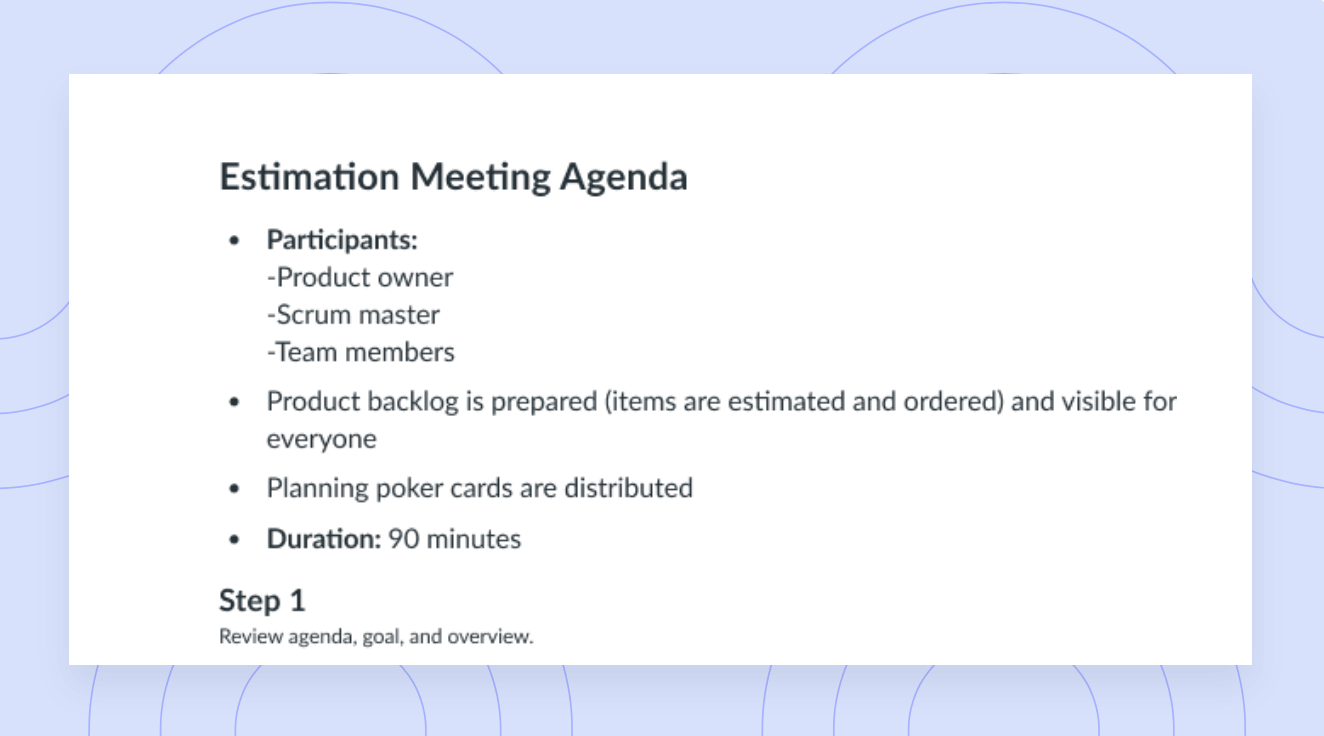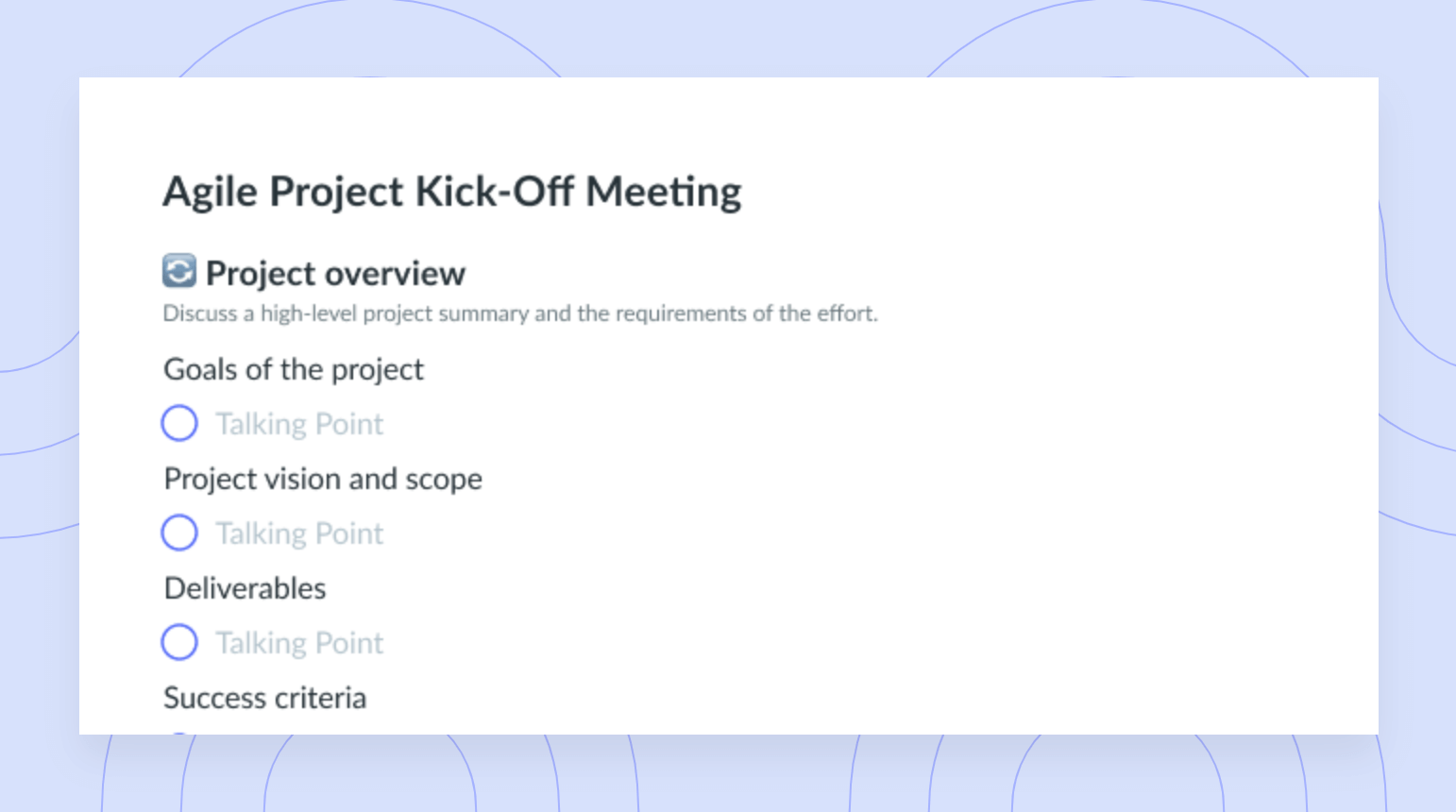Backlog Grooming 101: What It Is and Tips To Get It Right
Backlog grooming meetings are a recurring event for agile product development teams. Learn 5 tips to run them effectively.
Backlog grooming meetings are an essential effort if you want to improve both the speed and efficiency of projects, you want to reduce scope creep, and want to increase the development teams’ understanding of project deliverables. Whether you call it a backlog grooming agenda, meeting, product backlog refinement meeting, or storytime session, Fellow has created a definitive guide for you so that you can get the most out of your backlog refinements.
As we all know too well, the product development process can get a little messy if it’s not managed delicately. Backlog grooming best practices are crucial to ensuring projects stay within their scope and are on track.
In this guide, you’ll gain an understanding of what backlog grooming is, who’s in charge of running these sessions, who you should invite, and how long they take. We also include 6 benefits of backlog grooming, how a product owner should prepare for backlog grooming and finally, 5 tips for effective backlog grooming meeting agenda that’ll make for much easier sprint planning.
Here’s a bit of a breakdown of what we’ll be exploring today:
- What is backlog grooming?
- Who runs backlog refinement sessions?
- Who attends backlog grooming meetings?
- How long should backlog grooming take?
- 6 benefits of backlog grooming
- Preparing for backlog grooming
- 5 tips for effective backlog grooming meetings
Keep scrolling for all things backlog grooming and how to get it right:
What is backlog grooming?
Let’s start by keeping it simple… In development, a backlog is essentially a list of things that needs to be done, including new features, bug fixes, improvements, changes to existing features, and other product initiatives. The product team must prioritize this backlog and deliver on the items on the list in order for a product to strategically move forwards and to ultimately be successful.
Backlog grooming takes place in a regular session where backlog items are reviewed, discussed, and then prioritized by the product owner, the project manager, and any other team member involved. This backlog includes the full set of user stories that aren’t in the current sprint that define the remainder of the project’s scope.
The goal of a backlog grooming session is to keep the team’s backlog up to date and make sure that backlog items are prepared for sprints or for sprint planning. This pre-planning and process of backlog refinement assists product managers explain the strategy that inspires updates and changes to the prioritized backlog items.

Who runs backlog refinement sessions?
This question depends on if you run an agile or scrum methodology. Typically, the product manager or the product owner would run and lead a backlog grooming meeting agenda and ensure they are executed successfully.
If you’re using an agile methodology, it wouldn’t be uncommon to see a project manager, scrum master or another team member take charge of an agile backlog grooming session as well.
“The Scrum Master is responsible for ensuring that refinement takes place, has the desired outcome and it does not cost an excessive amount of effort for the team,” says Sean Hoegaarden, a Product Owner and Scrum Master.
Whoever ends up running the refinement meeting should be responsible for the following things:
- Schedule the meeting in everyone’s calendars
- Build a collaborative meeting agenda for the session
- Keep the meeting on track
- Bring all voices into the conversation
- Track action items and send a follow up email

Pro tip
Use a meeting management tool like Fellow to collaboratively keep track of backlog items, talking points, and easily send meeting notes to attendees and stakeholders.

Who attends backlog grooming meetings?
Simply put: The product development team. If you’re wondering about who to invite to your backlog grooming session, try to think about sending your invite to the individuals who are the most involved in the product building process. This would generally include the facilitator of the meeting (again, this is usually a product manager or product owner but not exclusive to them), product managers and lead engineers.
Any other team members that may have valuable user insights related to the backlog will add value to the meeting with their attendance, as well. Team members from the quality assurance team, customer support or technical support should all be considered when sending out an invite.
How long should backlog grooming take?
Although you could spend hours discussing backlog items, we’d suggest capping your refinement meeting at 1 hour. Using this time frame is going to motivate you and the development teams to stay focused and keep the conversation on track.
“I generally find that having a one- or two-hour backlog grooming once per sprint (somewhere in the middle) tends to be sufficient to cut my teams’ planning sessions in half or more, as we have dedicated other time to answer questions and address any issues before we plan the next sprint,” says Cliff Gilley, a Product Leader and Agile Evangelist.
Sometimes, when we know we have more time, the conversation can deviate from its initial purpose. If you’re worried about not having quite enough time, we recommend using a meeting agenda template or simply assigning time slots to each user story, item or topic that needs to be discussed. The facilitator, which is usually your product manager or project manager will dedicate the time and attention required for each piece of the puzzle.

Pro Tip
Use one of Fellow’s pre-built templates to save time and spark ideas for your next meeting. Already have a favourite way to run your meeting? Build your own template, save it for later, and ditch the stress of creating an agenda from scratch.

6 Benefits of backlog grooming
Now that we’ve painted a picture that defines backlog grooming best practices, highlights who runs these meetings, illustrates who to invite to the refinement sessions and conveys how long they take, you’re ready to keep reading about the 6 major benefits of backlog grooming. Here they are at a glance:
- Boosts team efficiency
- Manages backlog chaos
- Delivers new information
- Keeps the backlog clean and relevant
- Keeps the whole product team up to date
- Increases work velocity
Now, let’s take a closer look:
Boosts team efficiency
One of the greatest benefits of backlog grooming is that it boosts the development team’s efficiency and productivity. When you engage in backlog grooming meeting agenda, it helps your team to push forward, with a focused vision and therefore, using each team member’s time more wisely. Where the user story should already be clearly and well defined, sprint planning requires a little more attention and a backlog will help you plan for your sprints more efficiently.
This is a great opportunity for the product manager (or facilitator) to explain the strategy that influences modifications to the prioritized backlog items and for the rest of the team to gain a stronger understanding of the details of the project.
When team members have a solid understanding of the project, they’re going to feel more focused and more confident in completing their responsibilities because they understand how their work fits into the bigger picture.
Manages backlog chaos
Because the backlog is always having items added to it, sometimes by upwards of 10 individuals in different positions, the backlog can get pretty loose. Backlog grooming agenda helps alleviate some of the messiness created by your product manager, project manager, developers, QA testers, or anyone else contributing (the mess is totally normal, BTW).
Your refinement sessions serve as a way to take that messy-looking list and create a manageable list of tasks that the team can refer to in order to prioritize their tasks appropriately.
Once you clean up your backlog, it’ll be a lot easier for your team to refer back to and to manage items on the list.
Delivers new information
You can look at backlog grooming as a communications tool because it circulates updated information to your entire team. It’s something your team is referring back to for updates and it ensures that everyone is on the same page. What’s even more beneficial than just you and your team getting updates as they occur, is that your information teams receive feedback from customers during demos. That way, after you showcase the product, the backlog captures stakeholder or customer feedback which will help you make adjustments and modifications as necessary.
Keeps the backlog clean and relevant
Because your backlog is receiving input from a lot of different people and sometimes from different departments, it’s super important to keep it as clean as possible. Another major purpose of backlog refinement is to keep the backlog populated with initiatives that are relevant.
To identify and list relevant initiatives, make sure that items are documented clearly and prioritized in accordance with your team and any other parties involved. Make sure that you and your team are only committing to the most relevant tasks for delivery in the following sprint.
Keeps the whole product team up to date
When your backlog is refined, it keeps your whole product team up to date because it supports effective conversations and allows your team to be on the same page when it comes to any user insights, new features, bugs or any other product-related updates.
Conversely, when a backlog is unorganized, the urgency of items becomes unclear and it can lead to miscommunication across individuals and teams. If you don’t catch it before it’s effects ripple, it could lead to poor product decisions.
To avoid this whole fiasco, make sure you and your team are updating your backlog in real-time so that you can keep up-to-date.
Increases work velocity
When your backlog is looking clean and shiny, it’s going to help your product teamwork a lot faster and in a more focused manner. Productivity increases when your backlog is refined because the product owner, product manager and project manager need to spend less time on the backlog and more time planning sprints. A groomed backlog is going to support the company to keep moving forwards.
How should a product owner prepare for backlog grooming?
Before the backlog grooming meeting, there are three things you should do to get in the right mindset:
- Review your objectives
- Talk to your stakeholders
- Review your key metrics
1 Revisit strategic objectives
To prepare for backlog grooming, think back to the overarching strategy that you’ve already outlined in the product roadmap. If you can keep the high-level objectives in mind before you refine the backlog, it’ll help you remain focused when you make decisions to prioritize certain items.
2 Talk to stakeholders
Talk to your stakeholders regularly! Sync up with your team and any other relevant counterparts or execs to get their feedback and adjust accordingly. It’s just as important to keep the conversation going with your customers or any other external stakeholders to get their feedback, too. Use this feedback from stakeholders to inspire your strategy.
3 Review key metrics
There’s no better way to prepare for your backlog grooming meeting than to take a look at your key metrics or OKRs. Monitor your key metrics to see if your items are prioritized accordingly and to notice if there have been any significant changes. Where there have been changes, think about how you can adjust the strategy so that you can still hit your main goals.
5 Tips for effective backlog grooming meetings
Write and include user stories
As a way to prepare for your backlog grooming meeting, break down user stories into smaller tasks. As the project evolves, new needs will arise and in response, those new user stories will need to be added to the backlog. Finally, you should break down user stories that have gotten larger than they should be, which is called splitting.
Build your discovery team
Because discovery is the first phase in development, you’ve got to make sure that you’ve built your team with the right individuals. Who is this for? What kinds of issues should the team anticipate or start exploring? This is the team that is defining the vision so it’s important everyone has a good understanding of what it’s going to take to achieve the goal.
Update priorities and estimates
Things are constantly changing in the product world, and that includes changes to priorities and estimates. Make sure that you and the members of your team are continuously updating your backlog, as changes happen so that any changes are reflected in the backlog and the listing of the user stories. Your backlog grooming serves as a consistent reassessment of the priority of user stories. Your estimates are also going to change, and these too need to be reflected in the backlog. Remember that changes need to be updated regularly! These updates should be shared during regular team meetings.
Find the right tools
Think about which tools are going to be the most efficient for you to collect data and share it. You can use a workflow tool, for example, a kanban board, so that you can collect and track the progress of your project. Visual tools will give users a better understanding of where the work is in terms of the cycle.
A meeting agenda tool like Fellow can help you assign, visualize, and prioritize all your meeting to-dos in one place.
Foster strong communication
Last but certainly not least, is that you need to foster strong communication in order to have an effective backlog grooming meeting. It’s really important to listen to your team members during these meetings and to keep an open mind when it comes to anything product related, and adjust accordingly. There needs to be a precedent set amongst all parties involved to respect the differences in opinion and utilize the different skills and competencies of all individuals. At the end of the day, you’re all working towards creating the best product possible.
Summary
Productive backlog grooming is a crucial skill to learn for product managers and their teams. You’re always going to have a backlog, but it’s not always going to be clean and easily understood. Backlog grooming sessions are dedicated to ensuring the highest priority item is at the top of the backlog and allows you to organize an appropriate number of items on the backlog list in order of priority.
Make sure to refer back to this guide anytime you need some reminders on what backlog grooming is and how to get it right. Use the 6 benefits of backlog grooming provided to motivate yourself and your team to keep organized and take a look over how a product owner can best prepare for backlog grooming.
Lastly, check out the 5 tips for effective backlog grooming meetings to improve your existing practices. Better yet, share this guide with any colleagues or friends who might need a refresher in the backlog grooming department!


![Software Engineering Scrum Meetings 101 [+ Free Templates]](https://fellow.app/wp-content/uploads/2022/07/Software-Engineering-Scrum-Meetings.jpg)



![Understanding Planning Poker: 6 Steps [+ Free Template]](https://fellow.app/wp-content/uploads/2022/08/Planning-Poker-2.jpg)





















